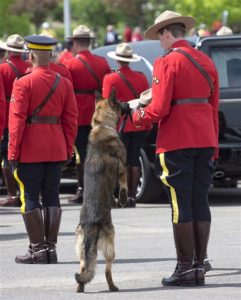FOR THE LOVE OF THE ANIMALS

Photo by Andrew Vaughan/Today
By Dr. Beth Leermakers
For an animal lover, one of the most heart-wrenching sights is a dog being dropped off by his family at an animal shelter. Many dogs whimper and cling to their people in apparent despair and confusion, wondering why they’re being left in a loud, scary place. When the dog is a grey-muzzled senior, the owner-surrender scenario is even more heart-breaking.
Dogs appear to mourn the loss of their people, whether it’s by death or abandonment. In 2014, Constable Dave Ross, a Canadian police dog handler, was killed in the line of duty. His service dog, a German Shepherd named Danny, worked alongside Ross during his time on the force. Throughout Ross’ funeral, his loyal canine partner whimpered next to Ross’ casket, apparently mourning the loss of his best friend.
Are we anthropomorphizing animals, or do they really experience grief? Research on animal sentience (the ability to feel, perceive or be conscious, or to have subjective experiences) has shown that animals from a wide variety of species experience emotions ranging from joy to deep sadness, grief and even post-traumatic stress disorder. Some animals even experience jealousy, empathy and resentment. Apparently, chickens, mice and rats display empathy. Who knew? Based on a systematic review of 2500 articles about animal sentience, the authors concluded that “evidence of animal sentience is everywhere.”
Furthermore, brain imaging studies using MRI have revealed striking similarities in how animals’ brains function. All animals — whether human or dog — share many common neural processes. When the same part of a dog’s brain is active (“lights up”) as a human’s under similar conditions, the implication is that the dog is experiencing something very similar to people. According to Dr. Marc Bekoff, professor of ecology and evolutionary biology at the University of Colorado Boulder, similar areas of dogs’ brains light up when they’re feeling parallel emotions to those of humans.
Signs of Grief
According to Barbara King, professor of anthropology at William and Mary and author of How Animals Grieve, grieving animals show distress through behavior that’s very different from usual. Dogs indicate sadness, anxiety and stress through behavioral changes, including:
• Panting
• Whining
• Barking
• Pacing
• Fidgeting
Other signs of canine grief are similar to symptoms of depression in people:
• Loss of appetite
• Weight loss
• Lack of energy
• Listlessless or clinginess
• Loss of interest in physical activity
Helping Your Dog Cope with Grief

Photo courtesy of The Daily Mail
There isn’t a single best approach for all dogs. However, experts recommend taking these steps to help your dog cope with the loss of a beloved family member:
Follow previous routines as much as possible. Many dogs, like people, seem to appreciate the security that comes from following a predictable routine, so maintain your grieving dog’s former exercise and eating schedules. If you’ve just adopted a shelter dog that lost his person through death or being surrendered, you won’t know what that dog’s previous routines entailed. In that case, just be consistent with your new dog’s feeding, exercise and rest/bedtime schedules moving forward.
Provide comfort by spending more time with your dog. As the weather cools off, take your dog with you to dog-friendly stores and restaurants. If you’re gone long hours, consider taking your pup to dog daycare one or two days per week or hiring a pet sitter to visit.
Your dog may prefer spending time with you, but he’s probably happier with friendly companionship than he is alone. In my experience as a foster mom, many sad/shy/scared dogs gain confidence from being around other well-adjusted dogs. I’ve watched my 10-year-old foster dog blossom from a shy, withdrawn dog into a happy, playful “puppy” who loves romping with his much younger foster siblings. If you’re not ready to make a life-long commitment to two new dogs, consider fostering one dog (perhaps an older, calm dog who knows the ropes) to be a companion to your adopted dog.
Give extra affection. Remember, a grieving dog may be clingier than usual. Reassure your dog by petting him and perhaps brushing him (gently – this should be pleasant). Touching your dog increases your bond. As an added bonus, petting a dog or cat can help release a relaxation hormone and reduce levels of a stress hormone — useful if you, too, are grieving the loss of a loved one. You and your dog can comfort each other.
Increase play and exercise time. Spend more time playing fetch, tug or whatever games your pooch prefers. Increase his daily walks (or runs). Research has shown that dogs, like people, experience an increase in endocannabinoids (endogenous neurotransmitters that produce the pleasant “runner’s high”) following aerobic exercise.
In other words, exercise may also produce a “runner’s high” for your dog. Exercise is often recommended as a treatment for dogs with behavioral problems.
Consult your veterinarian if your dog’s physical or emotional health declines. Your dog’s grief may be hiding symptoms of physical illness.
Like it does in people, grieving time varies in dogs. With time, most dogs recover emotionally. You can facilitate that recovery process by providing plenty of stability, affection and exercise for your grieving pooch.
